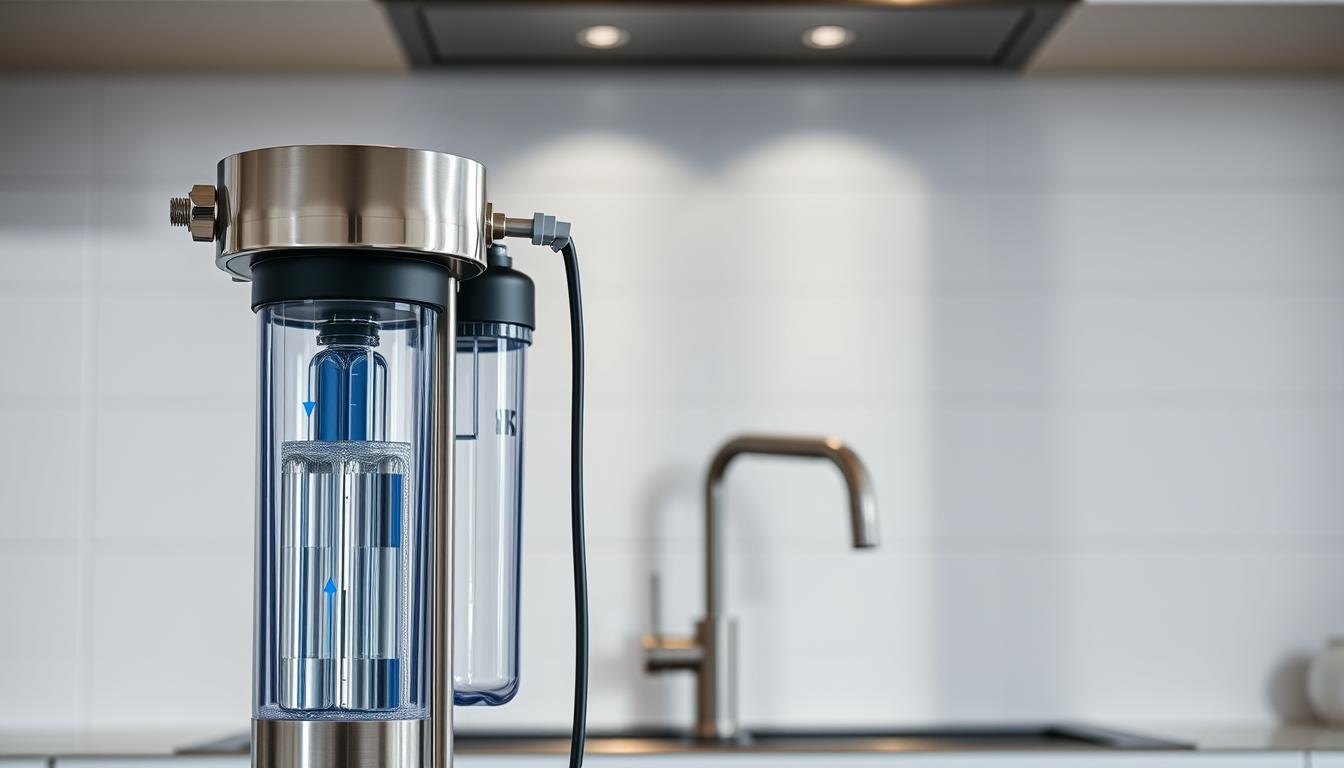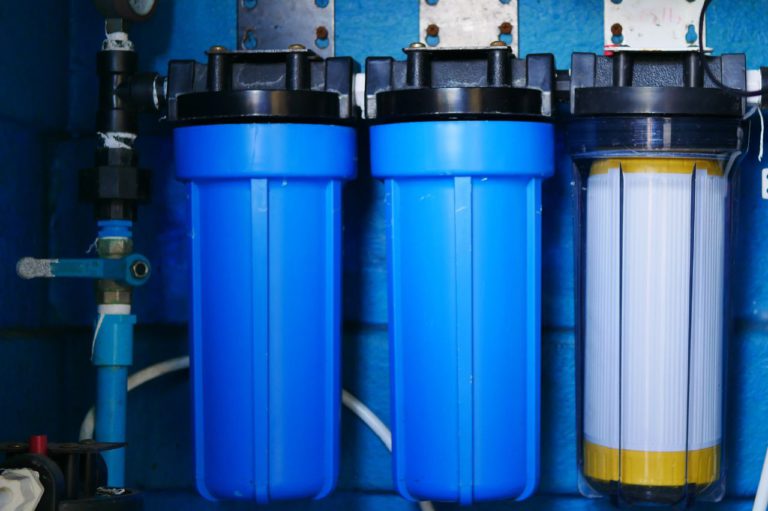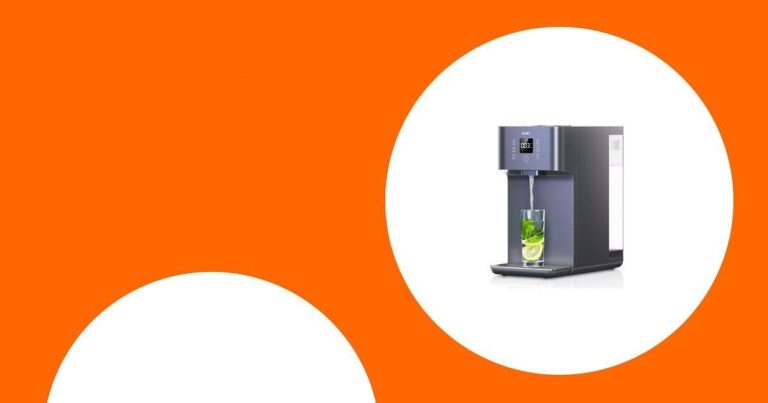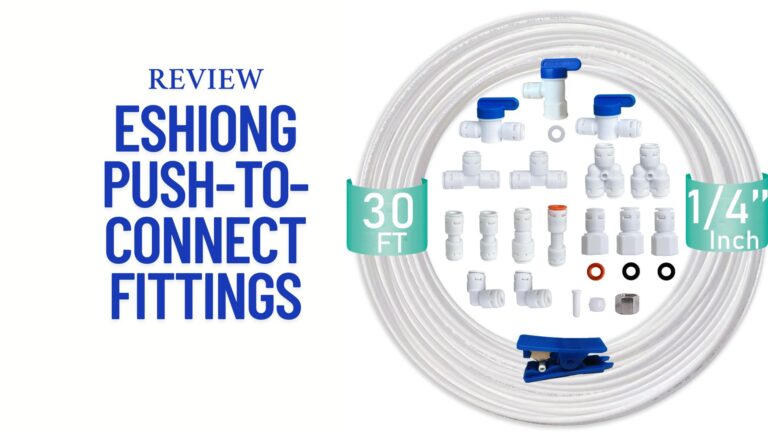How a 5-Stage RO Filter Improves Your Water
Are you tired of drinking water that tastes or smells bad? With a five stage reverse osmosis filter system, you can enjoy purified water right from the comfort of your own home.
This innovative filtration system is designed to remove impurities and contaminants, providing you with clean drinking water. By using a multi-stage process, it ensures that your water is not only safe to drink but also tastes great.
Imagine having access to purified water at any time, without the need for bottled water or worrying about the quality of your tap water. A five stage reverse osmosis filter makes this a reality, offering a convenient and cost-effective solution.
Key Takeaways
- Enjoy purified water at home with a five stage reverse osmosis filter system.
- Removes impurities and contaminants from drinking water.
- Multi-stage process ensures safe and great-tasting water.
- Convenient and cost-effective alternative to bottled water.
- Provides access to clean drinking water at any time.
Understanding Reverse Osmosis Technology
For many homeowners, understanding reverse osmosis technology is key to making informed decisions about water filtration. Reverse osmosis (RO) has become a widely accepted method for purifying water, and its effectiveness lies in its ability to remove a broad spectrum of contaminants.
The Science Behind Reverse Osmosis
Reverse osmosis works by applying pressure to force water through a semi-permeable membrane, which filters out impurities based on their size and charge. This process results in water that is significantly purer than the original source. The RO filtration system is designed to remove contaminants that other filtration methods might miss.
Historical Development of RO Filtration
The concept of reverse osmosis has been around for decades, initially developed for desalination purposes. Over time, the technology has evolved to become more efficient and cost-effective for household use. Today, reverse osmosis water filters are a common solution for improving drinking water quality.
Common Water Contaminants in American Homes
American homes can be susceptible to various water contaminants, including lead, chlorine, fluoride, and nitrates. These contaminants can affect the taste, odor, and safety of drinking water. An effective RO filtration system can remove up to 99% of these contaminants, ensuring cleaner and healthier drinking water.
How a Five Stage Reverse Osmosis Filter System Works
A five-stage reverse osmosis filter system is a sophisticated water purification system that ensures clean drinking water through a multi-step process. This system is designed to remove a wide array of contaminants, providing safe and healthy drinking water.
The Complete Filtration Process
The filtration process in a five-stage RO system involves several key steps. Initially, water passes through pre-filters that remove larger particles and contaminants. The water then undergoes reverse osmosis, where it is forced through a semi-permeable membrane that filters out dissolved solids and other impurities.
Water Flow Path Through the System
As water flows through the system, it first passes through a sediment pre-filter, which removes particulate matter. It then moves through a carbon pre-filter, which absorbs chlorine and other chemicals that could affect taste and odor. The water then reaches the reverse osmosis membrane, where the most significant filtration occurs.
Role of Pressure in RO Filtration
Pressure plays a crucial role in RO filtration. The system uses the water pressure from the household supply to force the water through the RO membrane. This pressure is essential for overcoming the natural osmotic pressure and ensuring that water passes through the membrane, leaving contaminants behind.
Contaminants Removed by RO Systems
RO systems are highly effective at removing a wide range of contaminants, including dissolved solids, bacteria, viruses, and heavy metals. The percentage of impurities eliminated can be quite high, often exceeding 99%.
Percentage of Impurities Eliminated
| Contaminant | Removal Percentage |
|---|---|
| Dissolved Solids | 95-99% |
| Bacteria and Viruses | 99.99% |
| Heavy Metals | 95-98% |
The effectiveness of a five-stage RO system makes it an excellent choice for households seeking to improve their drinking water quality. By understanding how the system works, users can appreciate the technology behind their water purification system.
Breaking Down the Five Stages of Filtration
To truly grasp the benefits of a 5-stage RO filter, it’s essential to examine each stage of its operation. The 5-stage RO filter is designed to provide comprehensive water purification, tackling various contaminants through a multi-layered approach.
Stage 1: Sediment Pre-Filter
The first stage of the filtration process involves the sediment pre-filter, which is crucial for removing larger particles such as dirt, rust, and sediment.
Removing Dirt, Rust, and Particles
This initial filter protects the subsequent filters from clogging and ensures that the water flowing through the system is free from visible impurities. By removing these larger particles, the sediment pre-filter prolongs the lifespan of the other filters in the system.
Stage 2: Carbon Pre-Filter
The second stage features a carbon pre-filter, which is designed to reduce chlorine and other chemicals that can affect the taste and odor of the water.
Chlorine and Chemical Reduction
By removing chlorine and other volatile organic compounds (VOCs), this filter improves the overall taste and smell of the water, making it more palatable for drinking.
Stage 3: Carbon Block Filter
The third stage utilizes a carbon block filter to further eliminate organic compounds and other impurities.
Eliminating Organic Compounds
This stage is critical for removing any remaining chemicals and improving the water’s taste. The carbon block filter provides an additional layer of protection against various contaminants.
Stage 4: Reverse Osmosis Membrane
The fourth stage is the heart of the 5-stage RO system: the reverse osmosis membrane.
The Heart of the System
This semi-permeable membrane is responsible for removing the smallest impurities, including dissolved solids, bacteria, and viruses, producing highly purified water.
Stage 5: Post-Carbon Filter
The final stage involves a post-carbon filter, which provides a last line of defense against any remaining impurities.
Final Polishing for Taste Improvement
This filter ensures that the water tastes fresh and clean, as it removes any residual odors or flavors before the water is dispensed.
Key Benefits of Using a Five Stage RO System
The best RO filter system for your home can significantly improve your drinking water’s taste and safety. A five-stage reverse osmosis system is designed to provide comprehensive water purification, addressing various contaminants and impurities.
Superior Contaminant Removal
One of the primary advantages of a five-stage RO system is its ability to remove a wide range of contaminants, including dissolved solids, bacteria, viruses, and heavy metals. This results in water that is not only safer to drink but also cleaner and more palatable.
Improved Taste and Odor
By effectively removing impurities, a five-stage RO system significantly enhances the taste and odor of your drinking water. This makes it particularly beneficial for households with well water or municipal water that may have an unpleasant taste or smell.
Long-Term Cost Savings
Although the initial investment in a five-stage RO system may seem substantial, it offers long-term cost savings. By reducing the need for bottled water and minimizing the frequency of filter replacements compared to other systems, homeowners can save money over time.
Convenience of Clean Water On Demand
Having a five-stage RO system installed at home means you have access to clean, purified water at your convenience. This is especially beneficial for families, as it ensures that everyone has access to safe drinking water without the hassle of frequently purchasing bottled water.
In conclusion, a five-stage RO system is an excellent choice for those seeking to improve their drinking water quality. With its superior contaminant removal, improved taste and odor, long-term cost savings, and convenience, it’s a valuable investment for any homeowner looking for the best RO filter system.
Health Advantages of Purified Water
Purified water from a residential reverse osmosis unit offers numerous health benefits. By removing various contaminants, it ensures the water is safe and healthy to drink.
Reduction of Harmful Chemicals
A residential reverse osmosis system is effective in removing harmful chemicals, including:
- Chlorine
- Pesticides
- Herbicides
Lead, Arsenic, and Heavy Metal Removal
These systems are particularly good at removing lead, arsenic, and other heavy metals, which are known to have serious health implications. Removing these contaminants significantly reduces the risk of various health issues.
Eliminating Microorganisms
Reverse osmosis systems also eliminate microorganisms, providing protection against waterborne illnesses.
Protection Against Waterborne Illnesses
By removing bacteria, viruses, and other pathogens, a residential reverse osmosis unit ensures the water is safe to drink, reducing the risk of waterborne diseases.
Benefits for Sensitive Individuals
For individuals with sensitive stomachs or weakened immune systems, purified water from a residential reverse osmosis unit can be particularly beneficial, offering a reliable source of clean drinking water.
Comparing RO Systems to Other Filtration Methods
In the quest for clean drinking water, comparing RO systems to other filtration methods can help homeowners make informed decisions. Reverse Osmosis (RO) systems are renowned for their ability to remove a wide array of contaminants, but how do they stack up against other popular filtration methods?
RO vs. Carbon Filtration
Carbon filtration is effective against chlorine, taste, and odor, but it falls short in removing dissolved solids and certain chemicals. In contrast, a top rated reverse osmosis system can remove up to 99% of contaminants, including dissolved solids.
RO vs. Distillation
Distillation involves boiling water and then condensing it, effectively removing many contaminants. However, it can also remove beneficial minerals and is energy-intensive. For a detailed comparison, visit this resource.
| Filtration Method | Contaminants Removed | Energy Efficiency |
|---|---|---|
| RO Systems | Up to 99% of dissolved solids, bacteria, viruses | High |
| Distillation | Many contaminants, but may leave behind volatile compounds | Low |
| Carbon Filtration | Chlorine, taste, odor, some chemicals | High |
RO vs. UV Purification
UV purification is excellent for killing bacteria and viruses but doesn’t remove dissolved solids or other contaminants. A top rated reverse osmosis system provides comprehensive contaminant removal.
RO vs. Water Softeners
Water softeners are designed to remove calcium and magnesium, which cause water hardness. While they improve water quality in terms of hardness, they don’t remove other contaminants like RO systems do.
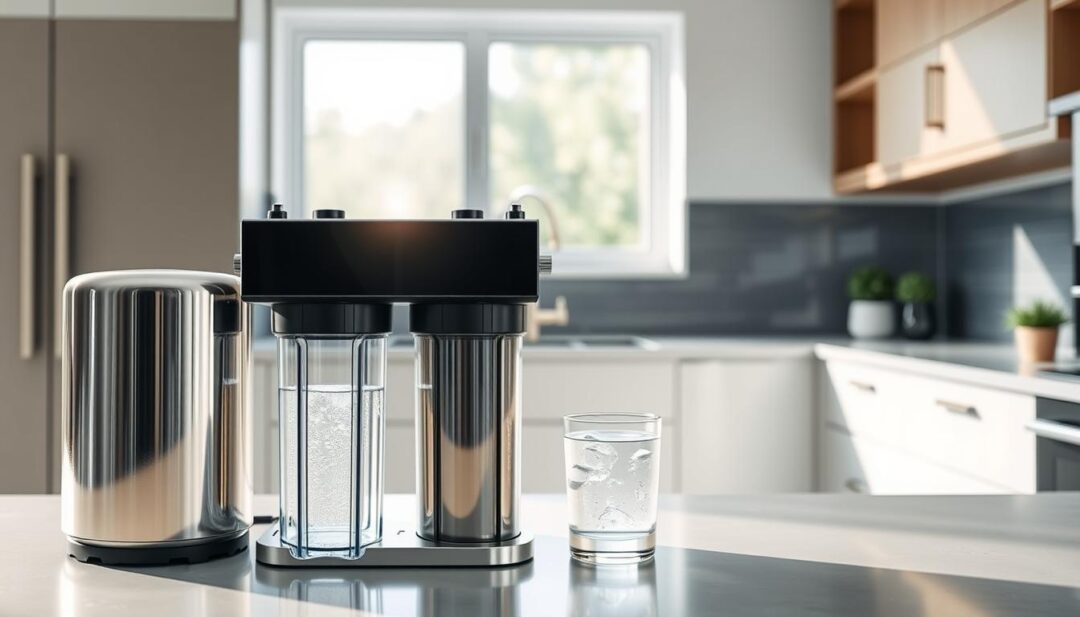
When choosing a water filtration system, it’s essential to consider the types of contaminants you need to remove and the maintenance requirements of the system. A top rated reverse osmosis system offers a robust solution for comprehensive water purification.
Installation Guide for Residential RO Systems
The installation of a residential RO system is a critical step in ensuring you have access to clean drinking water. A properly installed five-stage reverse osmosis filter system can provide you with years of reliable service, supplying your home with purified water.
DIY Installation Steps
Tools and Materials Needed
Before starting the installation, gather the necessary tools and materials. You will need a drill, wrench, Teflon tape, and the RO system components.
Step-by-Step Process
Begin by turning off the water supply and drilling a hole for the faucet. Then, mount the faucet and connect the water supply lines. Next, install the pre-filters and the reverse osmosis membrane according to the manufacturer’s instructions. Finally, connect the system to the water supply and check for leaks.
“Proper installation is key to the optimal functioning of your RO system.”
When to Call a Professional
If you’re not comfortable with DIY projects or if your plumbing is complex, it’s advisable to hire a professional. They can ensure the system is installed correctly and functions as expected.
Space Requirements and Considerations
Under-Sink Configuration
Most residential RO systems are designed to fit under the sink. Ensure you have enough space and that the area is well-ventilated.
Connecting to Refrigerators and Ice Makers
If you want to supply purified water to your refrigerator or ice maker, you’ll need to consider additional tubing and fittings. Some systems come with dedicated lines for this purpose.
| Component | Description | Consideration |
|---|---|---|
| Pre-filters | Remove sediment and chlorine | Replace every 6-12 months |
| RO Membrane | Removes dissolved solids | Replace every 2-3 years |
| Post-filter | Improves taste and odor | Replace every 12 months |
By following these guidelines, you can successfully install a RO filtration system in your home, ensuring a steady supply of clean drinking water.
Maintenance Requirements and Filter Replacement
The longevity and effectiveness of your reverse osmosis water filter depend on proper maintenance. Regular upkeep ensures that your system continues to provide clean, purified water.
Recommended Maintenance Schedule
To keep your reverse osmosis system in top condition, follow this maintenance schedule:
- Replace pre-filters every 6-12 months
- Change the RO membrane every 2-3 years
- Sanitize the system annually
First Year Maintenance Timeline
During the first year, monitor your system’s performance closely. Check for any signs of wear or decreased water quality.
Signs Your Filters Need Replacing
Look out for decreased water flow, unusual tastes, or odors. These are indicators that your filters may need replacing.
Cost of Replacement Filters
Replacement filter costs vary depending on the manufacturer and model. Budgeting for regular replacements is essential.
Sanitizing Your RO System
Sanitizing your system annually helps prevent bacterial growth. Use a sanitizing solution recommended by the manufacturer.
Common Issues and Troubleshooting Tips
Users of reverse osmosis systems often experience common problems that can be easily resolved with the right troubleshooting techniques. A well-functioning water purification system is essential for clean drinking water.
Slow Water Flow Problems
Slow water flow can be caused by clogged filters or low water pressure. Check your system’s filters and replace them if necessary.
Diagnosing Pressure Issues
To diagnose pressure issues, check the system’s pressure gauge and ensure it is within the recommended range. For more detailed troubleshooting, visit this guide.
Unusual Tastes or Odors
Unusual tastes or odors can be a sign of filter exhaustion or contamination. Check and replace the filters, and sanitize the system.
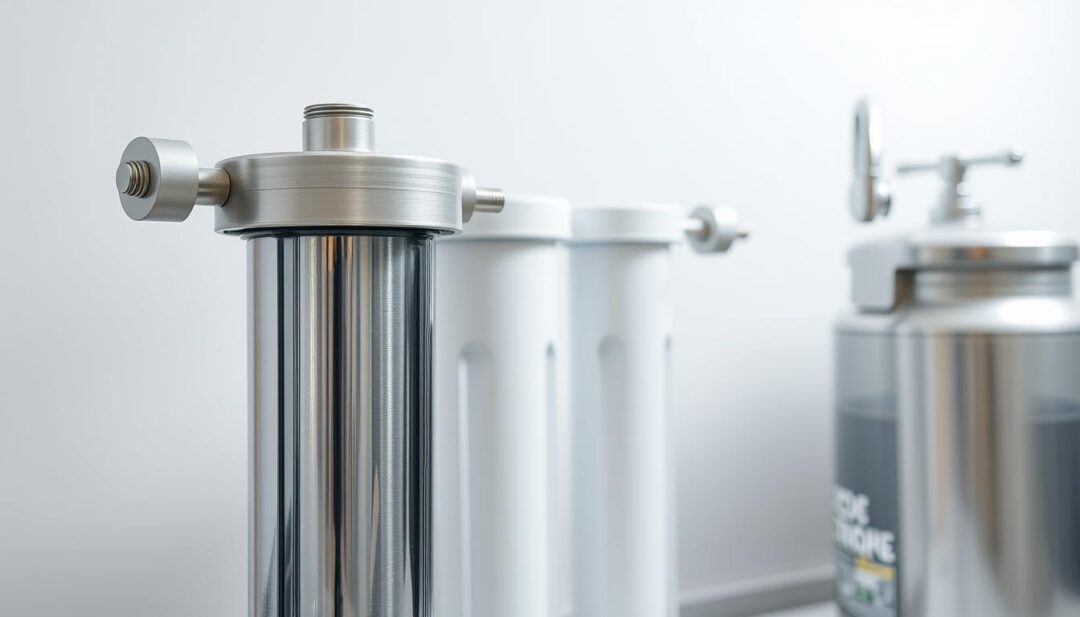
System Leaks and Fixes
Inspect the system for any signs of leakage and tighten any loose connections. Replace damaged parts if necessary.
Tank Not Filling Properly
If the tank is not filling properly, check for clogs in the system and ensure the tank is not overfilled.
Environmental Considerations of RO Systems
As the use of RO filtration systems becomes more widespread, their environmental implications are coming under scrutiny. While RO systems provide clean drinking water, their overall ecological footprint must be considered.
Water Waste Concerns
One of the significant environmental concerns associated with RO systems is water waste. Traditional RO systems can waste a considerable amount of water during the filtration process.
Typical Waste-to-Product Ratios
| RO System Type | Waste-to-Product Ratio |
|---|---|
| Standard RO | 3:1 to 6:1 |
| Eco-Friendly RO | 1:1 to 2:1 |
Eco-Friendly RO Options
In response to water waste concerns, manufacturers have developed eco-friendly RO systems that minimize waste. These systems often include features like water-saving technologies.
Zero Waste Modifications
Some modern RO systems are designed with zero waste modifications, utilizing advanced technologies to recycle or reuse the wastewater.
Responsible Filter Disposal
Another environmental consideration is the disposal of used filters. It’s essential to dispose of these filters responsibly, following local regulations and guidelines.
By understanding the environmental considerations of RO systems, consumers can make informed decisions about their water filtration needs, balancing the benefits of clean drinking water with ecological responsibility.
Selecting the Right Five Stage Reverse Osmosis System for Your Home
With numerous options available, selecting the ideal five-stage RO filter for your home requires careful consideration. A five-stage reverse osmosis system is a significant investment in your health, and choosing the right one can make all the difference in the quality of your drinking water.
Top Rated Systems on the Market
Several top-rated five-stage RO systems are available, each with its unique features and benefits. Some of the most popular include:
- Systems with advanced remineralization stages
- Filters with high-efficiency membranes
- Systems designed for low water waste
Features to Look For
When selecting a five-stage RO system, several key features should be considered:
Water Production Capacity
Ensure the system can produce enough clean water for your household’s needs.
Storage Tank Size
A larger tank can store more filtered water, but it also takes up more space.
Filter Quality and Lifespan
High-quality filters may cost more upfront but can provide better water quality and longer lifespan.
Budget Considerations
The cost of a five-stage RO system can vary widely, from a few hundred to over a thousand dollars. Consider not just the initial cost, but also the cost of replacement filters and maintenance.
Warranty and Customer Support
A comprehensive warranty and reliable customer support can provide peace of mind and protect your investment. Look for manufacturers that offer robust support and a reasonable warranty period.
By carefully considering these factors, you can select the best RO filter system for your home, ensuring access to clean, healthy drinking water for years to come.

Conclusion: Embracing Cleaner, Healthier Water
Investing in a top rated reverse osmosis system is a significant step towards ensuring access to clean drinking water. A residential reverse osmosis unit, particularly a five-stage system, provides comprehensive protection against a wide range of contaminants.
By understanding the benefits and maintenance requirements of these systems, homeowners can enjoy purified water that is not only healthier but also tastes better. Regular maintenance, including replacing filters and sanitizing the storage tank, is crucial for the longevity and effectiveness of the system.
For more detailed information on maintaining your RO water purifier, you can visit this resource to learn about recommended service intervals and troubleshooting tips.
Making the switch to a five-stage reverse osmosis filter system is a decision that supports the health and well-being of you and your family. With its ability to remove a broad spectrum of contaminants, a top rated reverse osmosis system is an invaluable addition to any home.
FAQ
What is a five-stage reverse osmosis filter system?
How often should I replace the filters in my RO system?
Can I install a five-stage RO system myself?
How much water does a reverse osmosis system waste?
Will a five-stage RO system remove beneficial minerals from my water?
Can I use a five-stage RO system with a well or city water supply?
How do I know if my RO system is working correctly?
Are five-stage RO systems certified by reputable third-party organizations?
As an Amazon Associate, I earn from qualifying purchases. This means if you click on an Amazon link on this site and make a purchase, I may receive a small commission at no extra cost to you. This helps support the blog and allows me to continue providing helpful content. Thank you for your support!

